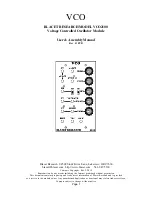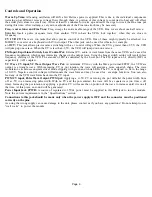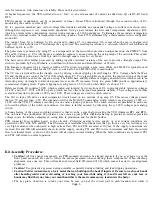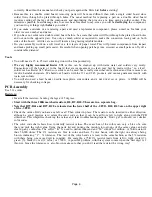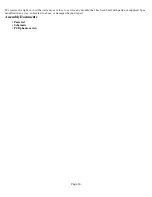
Page 7
Tolerance (gold = 5%, brown = 1%)
Multiplier (# of 0
ʼ
s)
2nd digit
1st digit
Resistor Color Codes
Black = 0
Brown = 1
Red = 2
Orange = 3
Yellow = 4
Green = 5
Blue = 6
Violet = 7
Gray = 8
White = 9
3rd digit (only on 1% resistors)
For example: green (5), blue (6), orange (3 zeros), gold
(5%)= a 56000 or 56K ohm, 5% tolerance resistor.
For example: violet (7), green (5), black (0), red (2 zeros),
brown (1%)= a 75000 or 75K ohm, 1% resistor.
Diodes:
Insert and solder the diodes: Note the orientation.
PCB Symbol
Diode
Resistor Networks:
Observe the orientation.
IC Sockets:
These will have a keyway or dot (pin 1) to indicate the correct orientation. Insert the socket and bend one leg
at two opposing corners 45 degrees or so. Solder these two pins and check to see that the socket is flush with the board.
Then solder all the pins.
Jacks:
Load the 12 jacks into the PCBs. Since these will have to go through the front panel later, precise mounting is a
must. Carefully insert all jacks,
noting that J12 goes on the solder side of the board.
• Tip:
Keeping the jacks in the board can be challenging but one useful trick is to bend the front pin forwards just a
bit before inserting. Install the front pin first, pushing a bit forward to get the rear pins in place.
Solder
only the front pin
while applying a bit of pressure to the PCB in the vicinity of the jack. Do all the jacks and check
the mounting before soldering any other pins. Close one eye and sight down the row of jacks. Each jack must be flush to
the board and have no tilt from front to back. When everything looks perfect, solder the other pins.
Capacitors:
(
Cap
). There are several different types. You may need a magnifier to read the code on the small ceramics.
• Note that the electrolytic type must be properly oriented. Insert the side which has the
longer lead
closest to the
“+” on the silkscreen. The opposite side of the capacitor
should have a row of “-”.
Polyswitches:
(
PTC
) PS1 and PS2. These have kinked legs.
Power Input Jack:
JPWR; note the orientation as shown by the silkscreen.
Test Point:
Loop a piece of resistor lead trimming and insert at “TP-1”. Leave a loop above the PCB and solder.
Reference Diode:
D1. Note orientation of the T0-92 package.
Trim Pots :
Install RT1, the 20T trimmer with the brass screw closest to the silkscreen dot. Install the other trimmers.
Transistors:
Install, noting the correct orientation.
For the LS318 transistor: Q1, TO-72 (metal can, six leads), note the tab location on both the part and the PCB silkscreen.
Use a pair of small needle nose pliers to form the leads to fit the six holes on the PCB, Start with a 45 degree bend close to
the body (about .050 to .075) and then a right angle bend as needed to space the legs wide enough for the holes in the
PCB. Insert the transistor, making sure it is parallel to the board before
soldering the outer four legs only
.
Locate R18, the 1K temperature compensating resistor. Bend the legs to .4” and insert into the board so that it sits
on top
of Q1. Carefully snug down the leads and solder along with the remaining two legs of Q1.
LEDS:
Observe orientation as shown for the diodes above. Position above the board by about 0.2”.

